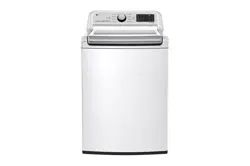Documents: Go to download!
- User Manual - (English)
- PRODUCT FEATURES
- INSTALLATION
- OPERATION
- MAINTENANCE
- TROUBLESHOOTING
Table of contents
OWNER'S MANUAL WASHING MACHINE
PRODUCT FEATURES
INSTALLATION
Installation Overview
Please read the following installation instructions first after purchasing this washer or transporting it to another location.
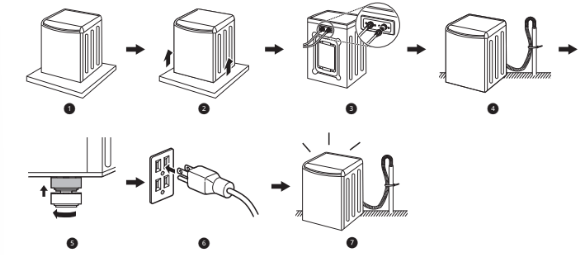
- Choosing the Proper Location
- Unpacking and Removing Shipping Material
- Connecting the Water Inlet Hoses
- Connecting the Drain Hose
- Leveling the Washer
- Connecting to the Power Supply
- Final Installation Check
How to Connect the Water Inlet Hoses
1. Check the fittings and seals.
- Inspect the threaded fitting on each hose and make sure there is a rubber seal (1) in place in both ends of each hose to prevent leaking.

2. Connect the water supply hoses.
- Connect the water inlet hoses to the hot and cold water faucets tightly by hand and then tighten another 2/3 turn with pliers.
- Connect the blue hose to the cold water faucet and the red hose to the hot water faucet.
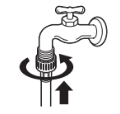
3. After the hoses are connected, turn on the water faucets and flush out any foreign substances such as dirt, sand, or sawdust.
- Let the water drain into a bucket, and check the water temperature to make sure you’ve connected the hoses to the correct faucets.

4. Attach the inlet hoses to the back of the washer.
- Attach the hot water inlet hose to the hot water inlet on the back of the washer. Attach the cold water inlet hose to the cold water inlet on the back of the washer.
- Tighten the fittings securely. Turn on both faucets all the way and check for leaks at both ends of the hoses.

Using a Standpipe to Drain
1. Insert the end of the drain hose into the standpipe.
2. Use the provided tie strap (1) to secure the drain hose in place.
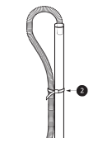
3. If the water valves and drain are built into the wall, fasten the drain hose to one of the water hoses with the provided tie strap (2) (ribbed side on inside).
NOTE: If the drain is large enough for the flange on the hose to fit inside, then do not insert the flange more than 1 - 2 inches into the drain.
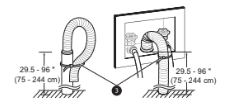
Using a Laundry Tub to Drain
- Hang the end of the drain hose over the side of the laundry tub.
- Use the provided tie strap to secure the drain hose in place.
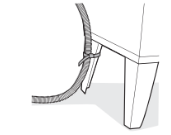
How to Level the Washer
1. Position the washer in its final location.
- Take special care not to pinch, strain, or crush the water and drain hoses. If you have a carpenter’s level (1), you can use it to check that the washer is level. The slope beneath the washer should not exceed 1 inch, and all 4 leveling feet must rest firmly on the floor.
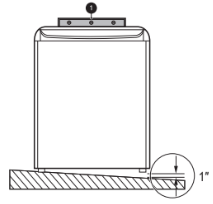
2. Open the lid and look from above to see if the tub is centered.
- If the tub is not centered, readjust the front feet. If you have a level, check the washer with the level.
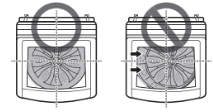
NOTE: To check if the washer is level from side to side, place a level on the back edge of the lid. To check if the washer is level from front to back, place a level on the edge where the cabinet side meets the top cover. Do not place the level on the top of the lid. Using these surfaces will result in the washer being unlevel.
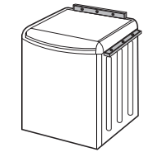
3. Adjust the leveling feet.
- Turn all 4 leveling feet in one direction to raise the washer or the other direction to lower it.

4. Recheck the washer’s levelness.
- Push or rock the top edges of the washer gently to make sure the washer does not rock. If the washer rocks,readjust the leveling feet.
- If the lid does not stay open properly, extend the front leveling legs until the washer is level from front to back.
Testing the Washer
Check if the washer is properly installed and run a test cycle.
1. Make sure that the tub is empty. Do not load anything in the tub for this test. Make sure that the water faucets for the washer are fully turned on.
2. Press the Power button.
3. Press and hold the Spin and Soil buttons simultaneously until an In 5 code appears in the display.
- In is displayed first, and 5, 5O, or 5E is displayed.
- In 5 : Initial test
- In 50 : Previous test result was good.
- In 5E : Previous test ended with an error.
- The indication is different for each model.
5. Press the Start/Pause button.
- The test will run for about 3 minutes.
- The test automatically checks the water inlet hoses and the drain hose.
6. Check the display for results.
7. At the end of the test cycle, ENd or O will display. The washer will shut off automatically after a short delay.
OPERATION
Sorting Laundry
Grouping Similar Items
- For the best washing results, and to reduce the possibility of damage to clothing, sort clothing into loads made up of similar items.
- Mixing different fabric types and/or soil levels can result in poor wash performance, color transfer, discoloration, fabric damage or linting. Fabrics should be sorted into groups as described below.
Colors
- Sort articles by color. Wash dark clothes separately from light colors or whites. Mixing dark clothes with light clothes can result in dye transfer or discoloration of the lighter clothes.
Soil Level
- Wash heavily soiled clothing together. Washing lightly soiled clothing in the same load with heavily soiled clothing could result in poor wash performance for the lightly soiled clothing.
Fabric Type
- Delicate articles should not be mixed with heavy or sturdy fabric types. Washing heavy fabrics with delicates can result in poor wash performance for the heavy fabrics and possible damage to the delicates.
Lint Type
- Some fabrics attract and bind lint to them while others give off lint in the laundry process. Avoid mixing these lint collectors and lint producers in the same load. Mixing these fabrics will result in pilling and linting on the lint collectors. (For example, lint collector - knit sweater; lint producer - terry cloth towels.)
How to Sort Laundry

CAUTION
- The washer can be fully loaded, but the tub should not be tightly packed with items. The lid of the washer should close easily.
- Use the Bedding cycle for buoyant or nonabsorbent items such as pillows or comforters. Failure to follow this caution can result in leakage.
- Clothing or articles that are waterproof or water resistant must be washed in the Waterproof cycle only. (Examples include water resistant clothing, mattress covers, outdoor clothes, and plastic mats.) Using another cycle may result in personal injury or damage to the washer, clothes, walls, floor, and surrounding objects due to abnormal vibration.
Fabric Care Labels
Many articles of clothing include a fabric care label. Using the chart below, adjust the cycle and option selections to care for your clothing according to the manufacturer’s recommendations.
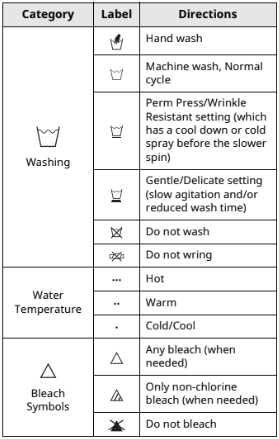
Loading the Washer
General Tips
- Check and empty pockets. Paper clips, coins, matches, and other items can damage clothing and the washer.
- Close zippers and hooks, and tie drawstrings to prevent snagging or tangling of clothes.
- Pretreat heavily stained areas for best results.
- Brush off heavy soil, dust, and hair from items before washing. Excess dirt or sand can abrade other fabrics and lead to poor wash performance.
- Combine large and small items in the tub. Load large items first. Large items should not be more than half of total load.
- For best results, load dry items only. If washing very wet items, wring out excess water before loading, or run a Spin Only cycle to extract excess water before adding detergent and starting the desired cycle.
- The washer can be fully loaded, but the tub should not be tightly packed with items. The lid of the washer must close easily.

- The washer will not fill or operate with the lid open.
- Do not overload the tub. Clothes should fit loosely in the tub under the maximum fill line (1). Loading clothes over the fill line may result in damage to clothing and the washer.
- Do not press down on items while stacking them in the tub.
- Load clothes loosely, and do not overfill the tub. Clothes need room to circulate in order to get clean.
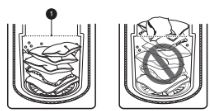
Bulky Items
- Do not wash entire pillows or cushions. Remove pillow or cushion inserts and wash the covers only.
- Use the Bedding cycle for large or bulky items such as poly-filled jackets, comforters, pillows, etc. These items may not be as absorbent as other laundry items and should be sorted into a separate wash load for best performance.
- Bulky items should be placed as far down in the tub as possible for best performance. Always place buoyant items at the bottom of the tub. The washer will automatically detect the load size. Because of the high efficiency wash system, the water level may not completely cover the load.
Small Items
- Do not wash a single small item. Add enough similar items to the load to prevent an out-of- balance load.
- Wash small, light items in a mesh bag. Small items can get caught in the impeller at the bottom of the tub, and brassiere hooks can damage other items or the tub.
Adding Cleaning Products
About Detergent Use
This washer is designed for use with only HE (High- Efficiency) detergents.
- HE detergents produce fewer suds, dissolve more efficiently to improve washing and rinsing performance, and help to keep the interior of the washer clean. Using detergent that is not HE may cause oversudsing and unsatisfactory performance which could result in error codes, cycle failure, and washer damage.
- Detergents designated as HE-compatible may not provide optimal results.
- For proper wash performance, always measure detergent using the measuring device provided by the detergent manufacturer. For an average load, use less than half of the recommended maximum. Use less detergent for soft water, light soil, or smaller loads.
- Use extra care when measuring 2X and 3X concentrated detergents because even a small amount of extra detergent can lead to problems.
- Never use more than the maximum amount of detergent recommended by the manufacturer. Using too much detergent can lead to oversudsing, poor rinsing, detergent buildup in clothing, and residue buildup that can contribute to odors in the washer.
- Do not use more than one single-use detergent pack or detergent tablet in the washer. Using too much detergent may cause oversudsing and unsatisfactory performance. Reduce detergent amount or add an extra rinse if detergent residue is left on fabrics. To add an extra rinse, select the Extra Rinse option.

1 Maximum fill line
2 Average load fill line
3 Liquid detergent
4 Powdered detergent
Using the Detergent and Softener Dispenser Drawer
To add detergent and fabric softener to the automatic dispenser drawer:
1. Open the dispenser drawer.
2. Load the laundry products into the appropriate compartments.
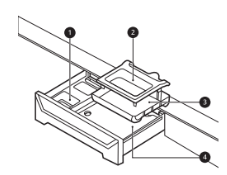
1 Liquid fabric softener compartment
See other models: LWS3063BD LFXS24623D LSXC22436S LFC22770ST LSCG367ST
2 Main wash liquid detergent cup
3 Insert
4 Main wash powdered detergent compartment
3. Gently close the detergent dispenser drawer before starting the cycle.
- Slamming the drawer closed may result in the detergent overflowing into another compartment or dispensing into the drum earlier than programmed.
- Be careful not to get a hand caught in the drawer while closing.
- It is normal for a small amount of water to remain in the dispenser compartments at the end of the cycle.
Using the Liquid Bleach Dispenser
The bleach dispenser is a separate compartment at the left front of the tub opening.
NOTE
- Do not add powdered bleach to this dispenser. The bleach dispenser is designed to dispense liquid bleach only. Powdered or liquid color-safe bleach will not dispense properly.
- Do not place laundry items on top of the bleach dispenser when loading and unloading the washer.
- Never add more than one cup of bleach and do not exceed the maximum fill line since this can cause the bleach to be dispensed immediately. Using too much bleach can damage fabrics.
- Never pour undiluted liquid chlorine bleach directly onto the load or into the tub. Fabric damage can occur.
- Do not use color-safe bleach or Oxi products in the same cycle with liquid chlorine bleach.
1. Check clothing care labels for special instructions.
2. Measure liquid bleach carefully, following the instructions on the bottle.
- HE (High-Efficiency) washers use less water, so less bleach is needed. One half cup is enough for most loads.
3. Carefully pour the pre-measured amount of bleach directly into the bleach dispenser.
- If you are using powdered bleach of any kind, pour it directly into the tub before adding the laundry.
- Never add powdered bleach to the liquid bleach dispenser.
Automatic Bleach Dispenser
On some models, the bleach dispenser is connected to the inlet valve. The bleach is automatically diluted and dispensed at the proper time in the wash cycle.
- The dispenser is activated twice to ensure complete dispensing of the bleach. Any liquid remaining in the dispenser at the end of the cycle is water, not bleach.
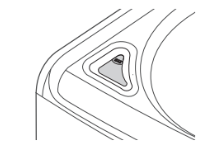
Immediate Bleach Dispenser
On some models, when you pour the bleach into the bleach dispenser, the bleach is immediately added to the tub as it fills with water, safely diluting the bleach.
- The dispenser cover cannot be removed. To clean the cover, wipe it with a damp paper towel.
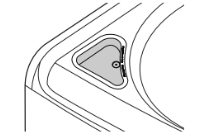
Cycle Modifiers
About Modifier Buttons
Each cycle has default settings that are selected automatically. You may also customize these settings using the cycle modifier buttons.
- Repeatedly press the button for the desired modifier until the indicator light for the desired setting is lit.
- The washer automatically adjusts the water level for the type and size of wash load for best results and maximum efficiency.
- This is a high-efficiency washer, and the water levels may be much lower than you expect. This is normal, and cleaning/rinsing performance will not be compromised.
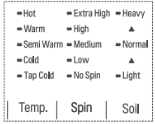
NOTE
- The LED next to the setting lights up when the setting is selected.
- To protect your garments, not every wash temperature, spin speed, soil level, or option is available with every cycle.
- A chime will sound twice and the LED will not light if the desired setting is not allowed for the selected cycle.
- Follow the fabric care labels on the garment for best results.
Temp.
Make sure the water temperature is suitable for the type of load you are washing.
- Press the Temp. button repeatedly to select the wash and rinse temperature combination for the selected cycle.
- All rinses use unheated cold water.
- Cold rinses use less energy. The actual cold rinse temperature depends on the temperature of the cold water at the faucet.
Spin
Higher spin speeds extract more water from clothes, reducing drying time and saving energy.
- Press the Spin button repeatedly until the desired speed is selected.
- Some fabrics, such as delicates, require a slower spin speed. To protect your clothing, not all spin speeds are available for all cycles.
Soil
Adjusting the soil level setting will modify the cycle times and/or wash actions.
- Press the Soil button repeatedly until the desired soil level is selected.
- The Heavy soil setting may increase cycle times. The Light soil setting may decrease cycle times.
Rinse+Spin
Select this option to rinse and spin a load separately from a regular cycle. This can be helpful in preventing fresh stains from setting in fabrics.
- Press the Power button to turn on the washer.
- Press the Special Care button repeatedly until Rinse+Spin is selected.
- Press the Start/Pause button to begin.
Add Garments
If you’ve forgotten to add an item or need to remove foreign objects like coins or keys after the cycle has started, the best time to do so is while the Add Garments indicator is on.
Once the indicator turns off, adding garments may affect the cycle time or wash performance.
- Press the Start/Pause button. The cycle pauses and the lid (door) unlocks.
- Open the lid, add garments or remove foreign objects, and close the lid.
- Press the Start/Pause button to resume the cycle. The cycle continues automatically.
NOTE
- This washer is equipped with a special drain feature that is designed to make your washer as safe as possible. If the washer is paused or shut off while there is still water in the tub, the water will drain automatically after several minutes of inactivity. This helps keep children safe by reducing the possibility of water remaining in the tub.
- Any water remaining in the tub will automatically drain 4 minutes after the washer has shut off. If the washer is paused and the Start/Pause button is not pressed within 60 minutes, the washer will shut off and all cycle settings will be lost. Any water remaining in the tub will be drained.
- The washer can be turned on or restarted any time before the drain begins. However, once the washer begins to drain, all controls and functions will be disabled until the water has been completely drained and the washer shuts off.
Spin Only
Use this option to spin clothes and drain the water from the tub.
Use this option to drain water if the wash cycle is interrupted by a power failure or to spin dry hand-washed items.
- Press the Power button to turn on the washer. Do not select a cycle.
- Press and hold the Spin button for 3 seconds. You can change the spin speed by pressing the Spin button.
- Press the Start/Pause button to begin.
Cold Wash
Use this option to save energy by using cooler water while increasing the wash and rinse times to maintain wash performance.
- Wash time will increase up to several minutes with this option.
- For best wash results, only wash small loads (less than 8 lb) with this option.
Delay Wash
Once you have selected the cycle and other settings, press this button to delay the start of the wash cycle.
- Each press of the button increases the delay time by 1 hour, for up to 19 hours.
- Once the desired delay time is set, press the Start/Pause button to start the delay time.
Extra Rinse
This option adds an extra rinse to the selected cycle. Use this option to help ensure the removal of detergent or bleach residue from fabrics.
- Pressing the Extra Rinse button twice will add two additional rinses to the cycle.
- If a liquid fabric softener is used, it is always dispensed in the final rinse.
Locking the Control Panel
- Turn on the power.
- Press and hold the Signal button for 3 seconds to activate this function.
Unlocking the Control Panel
- Turn on the power.
- Press and hold the Signal button for 3 seconds to deactivate this function.
When this function is deactivated, a chime will sound and the remaining time for the current cycle will reappear on the display.
Before Using LG ThinQ Application
- Use a smartphone to check the strength of the wireless router (Wi-Fi network) near the appliance.
If the appliance is too far from the router, the signal becomes weak. It may take a long time to register or fail to install the application.
- Turn off the Mobile data or Cellular Data on your smartphone.

- Connect your smartphone to the wireless router.

NOTE
- To verify the Wi-Fi connection, check that the f icon on the control panel is lit.
- The appliance supports 2.4 GHz Wi-Fi networks only. To check your network frequency, contact your Internet service provider or refer to your wireless router manual.
- LG ThinQ is not responsible for any network connection problems or any faults, malfunctions, or errors caused by network connection.
- The surrounding wireless environment can make the wireless network service run slowly.
- If the appliance is having trouble connecting to the Wi-Fi network, it may be too far from the router. Purchase a Wi-Fi repeater (range extender) to improve the Wi-Fi signal strength.
- The network connection may not work properly depending on the Internet service provider.
- The Wi-Fi may not connect or the connection may be interrupted because of the home network environment.
Using the Appliance Remotely
Using Remote Start
- Put the laundry in the drum and add detergent to the detergent dispenser drawer. If desired, add bleach or fabric softener to the appropriate areas of the dispenser.
- Press the Power button.
- Press and hold the Remote Start button for 3 seconds to enable the remote control function.
- Start a cycle from the LG ThinQ application on your smartphone.
NOTE
- Once this function is enabled, you can only start a cycle from the LG ThinQ smartphone application. If the cycle is not started, the appliance will wait to start the cycle until it is turned off remotely from the application or this function is disabled.
- If the door has been opened, you cannot start a cycle remotely.
MAINTENANCE
Regular Cleaning
Care after Wash
Always remove items from the washer as soon as the cycle is complete. Leaving damp items in the washer can cause wrinkling, color transfer, and odor.
After the cycle is finished, wipe the lid and the inside of the lid seal to remove any moisture.
- Wipe the body of the washer with a dry cloth to remove any moisture.
- Leave the lid open to dry the tub interior.
Cleaning the Exterior
Proper care of your washer can extend its life.
Lid:
- Wash with a damp cloth on the outside and inside and then dry with a soft cloth.
Exterior:
- Immediately wipe off any spills.
- Wipe with a damp cloth.
- Do not touch the surface or the display with sharp objects.
Periodic Maintenance
Cleaning the Tub
Over time, residue may build up in the tub, leading to mildew or a musty odor. Run the Tub Clean cycle monthly to remove residue and prevent odor.
1. Remove any clothing from the tub.
2. Adding cleaning agents.
- Tub cleaner/Lime scale remover: Follow manufacturer’s recommendations.
- Liquid chlorine bleach: Add to main wash liquid detergent dispenser.
- Powdered cleaner: Follow manufacturer’s recommendations.
- Cleaning tablets: Place directly into the washer tub.
3. Close the lid and press the Power button to turn on the washer.
4. Turn the knob or press the cycle buttons to select the Tub Clean cycle then press the Start/Pause button to begin the cycle.
5. After the cycle ends, open the lid and allow the tub interior to dry completely
Cleaning the Dispenser Drawer
Detergent and fabric softener may build up in the dispenser drawer. Remove the drawer and inserts and check for buildup once or twice a month.
1. Turn off the washer, and unplug the power cord.
2. Remove the drawer by pulling it straight out until it stops. Lift the front of the drawer upwards and pull it completely out.
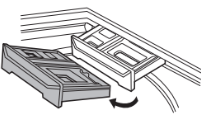
3. Remove the inserts from the two compartments.
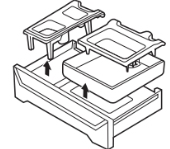
4. Clean the inserts and drawer with warm water.
- Use a soft cloth or brush to clean and remove any residue.
- Do not use soap when cleaning the drawer and inserts.
5. Wipe off any moisture with a dry towel or cloth after cleaning.
6. To clean the drawer opening, use a small, non-metal brush to clean the recess. Remove all residue from the upper and lower parts of the recess.
7. Return the inserts to the proper compartments and replace the drawer. Set the drawer into the opening at an angle, then lower it and slide it into place.
Cleaning the Water Inlet Filters
If the washer does not fill properly, an error message will appear on the display. The inlet valve filter screens could be clogged by hard water scale, sediment in the water supply, or other debris.
1. Turn off the washer, and unplug the power cord.
2. Turn off hot and cold water faucets.
3. Unscrew the hot and cold water hoses from the back of the washer.
4. Remove the filters from the water valves carefully. Use pliers to pull out the filters from the water valves.
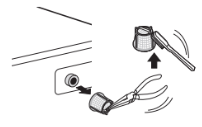
5. Remove foreign objects and soak the filters in white vinegar or a lime scale remover. If using a lime scale remover, follow the manufacturer’s instructions. Be careful not to damage the filters while cleaning them.
6. Rinse filters thoroughly and press them back into place.
7. Flush then reattach the water hoses. Before reattaching the water inlet hoses, flush them by running several gallons of water through them into a bucket or drain, preferably with the faucets wide open for maximum flow.
TROUBLESHOOTING
UE UNBALANCE ERROR
The load is too small.
- Add additional items to allow the washer to balance the load.
Heavy articles are mixed with lighter items.
- Always try to wash articles of somewhat similar weight to allow the washer to evenly distribute the weight of the load for spinning.
The load is out of balance.
- Manually redistribute the load if articles have become tangled, preventing the automatic rebalancing from working properly.
IE INLET ERROR
Water supply faucets are not fully open.
- Make sure that the water faucets are fully open.
Water inlet hoses are kinked, pinched, or crushed.
- Make sure that the hoses are not kinked, pinched or crushed behind or under the washer. Be careful when moving the washer during cleaning or maintenance.
Water inlet filters are clogged.
- Clean the inlet filters. See MAINTENANCE.
Water supply pressure to faucet or house is too low.
- Check another faucet in the house to make sure that household water pressure is adequate and flow is not restricted.
- Disconnect the water inlet hoses from the washer and run a few gallons of water through the hoses to flush out any dirt.
- If flow is too low, contact a plumber to have the water supply lines repaired.
Water supply connected with leak-limiting hoses.
- The use of hoses designed to limit leaks is not recommended. Leak-limiting hoses can trip falsely and prevent the washer from filling.
The end of the drain hose is lower than 29.5 inches (75 cm) above the bottom of the washer.
- Move the end of the drain hose so that it is higher than 29.5 inches (75 cm) above the bottom of the washer.
DE WATER OUTLET ERROR
Drain hose is kinked, pinched, or clogged.
- Make sure that the drain hose is free of clogs or kinks and is not pinched behind or under the washer.
The end of the drain hose is more than 96 inches (2.4 m) above the bottom of the washer.
- Move the end of the drain hose so that it is lower than 96 inches (2.4 m).
CL CONTROL LOCK FUNCTION
The control lock function is on to prevent anyone from changing cycles or operating the washer.
- Turn off the control lock function in the control panel. See Control Lock under Options and Extra Functions.
DRAIN FEATURE
Special drain feature
- If the washer is paused during a cycle for more than 4 minutes, the cycle will be canceled and any water remaining in the tub will be drained.
- This is not an error code. It indicates that the drain function is operating.
LID LOCK ERROR
Lid is not locked properly.
- Make sure that the lid is closed properly and press the Start/Pause button. You can hear the locking sound to lock the lid in the beginning of the cycle. The washer will not operate unless the lid is locked.
- Make sure that nothing is caught under the lid, including shipping material or clothing.
- Make sure that the latch mechanism is fully retracted.Make sure that the latch mechanism is fully retracted.
- If the lid is closed and this error message is still displayed, call for service.
LE I FOREIGN OBJECT ERROR
Foreign objects such as coins, pins, clips, etc., are caught between the pulsator and the inner tub.
- Turn the washer off then on again. Press the Spin button without selecting a cycle to drain and spin the load.
- When the Spin cycle is completed, empty the tub and find and remove any objects caught in the pulsator.
- Always check pockets, etc., before washing to prevent error codes or damage to the washer or clothing.
- For some models, LE is displayed first, then the 1 is displayed.
tcl TUB CLEAN ALARM
It is time to run the Tub Clean cycle.
- This is not an error code. It indicates that the Tub Clean cycle is running or needs to be run to clean the washer tub.
- For some models, tc is displayed first, then the L is displayed.
ub UNBALANCE DETECTION
The washer has detected an out of balance load.
- This displayc is for your information only, and no action is required. If the washer detects a load that is too far out of balance to spin, it will display this code while it is attempting to rebalance the load. The washer will add water and try to redistribute the load automatically.
- As a result, the cycle will take longer than initially estimated.
tE TEMPERATURE SENSOR ERROR
Control error
- Unplug the washer and wait 60 minutes. Reconnect power and try again.
- If the error code is still displayed, call for service.
FE OVERFLOW ERROR
Water level is too high due to a faulty water valve.
- Close the water faucets, unplug the washer, and call for service.
PE PRESSURE SENSOR ERROR
The water level sensor is not working correctly.
- Close the water faucets, unplug the washer, and call for service.
LE MOTOR LOCKED ERROR
A motor error has occurred.
- Allow the washer to stand for 30 minutes and then restart the cycle.
- If the error code is still displayed, call for service.
Eb CLUTCH ERROR
Clutch error
- Mechanical failure
- Unplug the washer and call for service.
PS SUPPLY VOLTAGE ERROR
Supply voltage is not correct.
- Please call LG service center. You can find your local LG service center phone number on the back cover page.
Clicking
Lid lock sounds when the lid locks or unlocks.
- Normal operation
Spraying or hissing
Water spraying or circulating during the cycle
- Normal operation
Humming or Gurgling
Drain pump is pumping water from the washer at times during a cycle.
- Normal operation
Water sloshing
A liquid in the balance ring around the pulsator helps the basket spin smoothly.
- Normal operation
Water being added after the washer has already begun to operate
The washer adapts to the load size and type to add more water to the cycle as needed.
- Normal operation
The wash load may be unbalanced. If the washer senses that the load is unbalanced, it will stop and refill to redistribute the load.
- Normal operation
The washer may be diluting laundry additives to add to the wash load.
- Normal operation
Vibrating noise
Packaging materials were not removed.
- See Unpacking and Removing Shipping Material in INSTALLATION.
Wash load may be unevenly distributed in the tub.Wash load may be unevenly distributed in the tub.
- Pause the cycle and redistribute the load after the lid unlocks.
Not all leveling feet are resting firmly and evenly on the floor.
- See Leveling the Washer in INSTALLATION.
Floor is not rigid enough.
- Make sure that the floor is solid and does not flex. See Flooring in INSTALLATION.
Squeaking noise
Packaging materials were not removed.
- See Unpacking and Removing shipping Material in INSTALLATION.
Banging noise when the washer is filling with water.(Water hammer)
Plumbing in the home moves or flexes when the water valves in the washer shut off.
- Water hammer is not caused by a defect in the washer. Install water hammer arrestors (purchased separately at hardware or home improvement store) between the fill hose and the washer for best results.
Household water supply pressure is very high.
- Adjust household water supply regulator to a lower pressure or contact a plumber.
Excessive sudsing
Too much detergent or incorrect detergent
- HE detergents are formulated specifically for HE (High-Efficiency) washers and contain suds reducing agents. Only use detergent with the HE (High-Efficiency) logo.
- For detergent quantities refer to Detergent Use in OPERATION. If sudsing or detergent residue continues to be an issue, add an extra rinse.
Washer will not turn on.
Power cord is not properly plugged in.
- Make sure that the plug is plugged securely into a grounded, 3-prong, 120-VAC, 60 Hz outlet.
House fuse is blown, circuit breaker has tripped, or power outage has occurred.
- Reset circuit breaker or replace fuse. Do not increase fuse capacity. If the problem is a circuit overload, have it corrected by a qualified election.
Wash cycle time is longer than usual.
The washer automatically adjusts the wash time for the amount of laundry, water pressure and other operating conditions.
- This is normal. The washer adjusts cycle time automatically to provide optimal results for the selected cycle. The time remaining shown in the display is only an estimate. Actual time may vary.
Incomplete or no dispensing of detergent
- Detergent compartments clogged from incorrect filling.
- Make sure that detergent and additives are put into the correct dispenser compartments.
- For all detergent types, always make sure that the dispenser drawer is fully closed before the start of the cycle.
- Too much detergent used.
- Make sure that the suggested amount of detergent is used according to the manufacturer’s recommendations. You may also dilute the detergent with water to the maximum fill line on the compartment to avoid clogging. Use only HE (High-Efficiency) detergent. Always use as little detergent as possible. HE (High-Efficiency) washers need very little detergent to achieve optimum results. Using too much detergent will cause poor wash and rinse performance and may contribute to odors in the washer.
- Insufficient water supply
- Make sure that both hot and cold water faucets are turned on all the way.
- Normal residue
- It is normal for a small amount of detergent to remain in the dispenser. If this residue builds up, it can interfere with normal dispensing of detergents. Refer to the cleaning instructions.
Washer will not operate.
- Control panel has powered off due to inactivity.
- This is normal. Press the Power button to turn on the washer.
- Washer is unplugged.
- Make sure that the power cord is plugged securely into an electrical outlet.
- Water supply is turned off.
- Turn both hot and cold faucets fully on.
- Controls are not set properly.
- Make sure that the cycle was set correctly, close the lid and press the Start/Pause button to start the wash cycle.
- Lid is open.
- Close the lid and make sure that noting is caught under the lid preventing it from closing completely.
- Circuit breaker/fuse is tripped/blown.
- Check house circuit breakers/fuses. Replace fuses or reset breaker. The washer should be on a dedicated branch circuit.
- Start/Pause button was not pressed after the cycle was set.
- Press the Power button then reselect the desired cycle and press the Start/Pause button. If the Start/Pause button is not pressed within a certain time, the washer will be turned off. (The time varies by model, from 4 to 60 minutes.)
- Extremely low water pressure.
- Check another faucet in the house to make sure that household water pressure is adequate.
- Washer is too cold.
- If the washer has been exposed to temperatures below freezing for an extended period of time, allow it to warm up before pressing the Power button. Otherwise, the display will not come on.
Washer is not filling properly.
- Filter is clogged.
- Make sure that inlet filters on the fill valves are not clogged. Refer to Cleaning the Water Inlet Filters in MAINTENANCE.
- Inlet hoses may be kinked.
- Check that inlet hoses are not kinked or clogged.
- Energy efficiency
- This is a High-Efficiency (HE) washer. As a result, the water level settings for this washer may be different than for conventional washer.
- Insufficient water supply
- Make sure that both hot and cold water faucets are turned on all the way.
- Washer lid is open.
- Close the lid and make sure that nothing is caught under the lid preventing it from closing completely.
- Water level is too low.
- The water will not normally cover the clothes. The fill level is optimized for the wash motion to achieve the best wash performance.
Water in the washer does not drain or drains slowly.
- Drain hose is kinked, pinched, or clogged.
- Make sure that the drain hose is free of clogs or kinks and is not pinched behind or under the washer.
- The end of the drain hose is more than 96 inches (2.4 m) above the bottom of the washer.
- Move the end of the drain hose so that it is lower than 96 inches (2.4 m).
Bleach does not dispense.
- Bleach dispenser cover is not properly installed (on some models).
- Make sure that the bleach cover is properly installed and snapped into place before the beginning of the cycle.
- Bleach dispenser is dirty or clogged.
- Lift out the bleach dispenser cover and clean out the reservoir. Lint and other foreign debris that are collected inside the dispenser may prevent proper dispensing of the bleach.
Premature dispensing of bleach
- Bleach dispenser filled for future load.
- You cannot store bleach in the dispenser for future use. The bleach will be dispensed every load.
- Overfilling the bleach dispenser
- Overfilling the bleach dispenser will cause the bleach to dispense immediately, which will damage the laundry or the washer. Always measure bleach, but never fill above the max line on the dispenser. A half cup of bleach is sufficient for most loads. Never use more than 1 cup of bleach.
Wrinkling
- Washer is not unloaded promptly.
- Always remove items from the washer as soon as the cycle is complete.
- Washer is overloaded.
- The washer can be fully loaded, but the tub should not be tightly packed with items. The lid of the washer should close easily.
- Hot and cold water inlet hoses are reversed.
- Hot water rinse can set wrinkles in garments. Check the Inlet hose connectors.
Staining
- Bleach or softener dispensed too soon.
- Dispenser compartment was overfilled, causing the bleach or softener to dispense immediately. Always measure bleach, and never use more than 1 cup.
- Bleach or softener was added directly to the wash load in the tub.
- Always use the dispensers to ensure that laundry products are properly dispensed at the right time in the cycle.
- Washer was not unloaded promptly.
- Always remove items from the washer as soon as possible after the cycle is completed.
- Clothes were not properly sorted.
- Always wash dark colors separately from light colors and whites to prevent discoloration.
- Never wash heavily soiled items with lightly soiled items.
Poor stain removal
- Proper options are not selected.
- Heavier soils and tougher stains may require extra cleaning power. Select the Soak or Stain Care feature to boost the cleaning power of the selected cycle.
- Previously set stains.
- Articles that have previously been washed may have stains that have been set. These stains may be difficult to remove and may require hand washing or pre-treating to aid in stain removal.
Musty or mildewy odor in the washer
- Incorrect or too much detergent has been used.
- Use only HE (High-Efficiency) detergent in accordance with the manufacturer’s instructions.
- Inside of the tub was not cleaned properly.
- Run the Tub Clean cycle regularly.
Your home appliance and smartphone are not connected to the Wi-Fi network.
- The password for the Wi-Fi that you are trying to connect to is incorrect.
- Find the Wi-Fi network connected to your smartphone and remove it, then connect your appliance on LG ThinQ.
- Mobile data for your smartphone is turned on.
- Turn off the Mobile data of your smartphone and connect the appliance using the Wi-Fi network
- The wireless network name (SSID) is set incorrectly.
- The wireless network name (SSID) should be a combination of English letters and numbers. (Do not use special characters.)
- The router frequency is not 2.4 GHz.
- Only a 2.4 GHz router frequency is supported. Set the wireless router to 2.4 GHz and connect the appliance to the wireless router. To check the router frequency, check with your Internet service provider or the router manufacturer.
- The appliance is too far from the router.
- If the appliance is too far from the router, the signal may be weak and the connection may not be configured correctly. Move the location of the router so that it is closer to the appliance.

